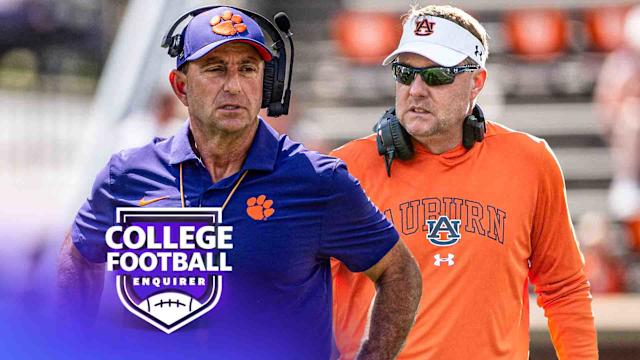
The Big Ten’s big mouths have lost the narrative war to the SEC so badly, it’s a small miracle when anything attributable to a Big Ten source these days isn’t accompanied by a laugh track.
The league’s latest misstep wasn’t even intended for public consumption. Yet somehow, it ended with Big Ten commissioner Tony Petitti stumbling into another public spanking while his counterpart at the SEC, Greg Sankey, continued to walk between raindrops and let everyone else feel the splashback.
Sources around the Big Ten insist that its absurd proposal to expand the College Football Playoff to 28 teams wasn’t really a proposal at all but something more akin to a late-night, three-bourbons-down conversation that shouldn't have left the group chat in the first place.
Still, the fact it saw the light of day — without Petitti immediately disowning it and the SEC one-upping him yet again by announcing last week that it would make the wildly popular move to nine conference games in 2026 — showed that the competition between the two heaviest hitters in college sports isn’t really a fair fight.
[Join or create a Yahoo Fantasy Football league for the 2025 NFL season]
The Big Ten may have won the last two national titles, but in terms of long-term strategy and message discipline, there’s no comparison. While the Big Ten looks like an out-of-touch corporate monolith trying to tell us that an 8-4 team should compete for a national title, the SEC sits back, watches its competitor's sweat drip for a little while and yells “checkmate” when they know it’ll hurt the most.
Remember earlier this year when it seemed like the Big Ten and SEC were going to jointly champion a 16-team playoff format with each of them getting four automatic bids? Once Sankey saw where the wind was blowing, he was more than happy to leave Petitti on Public Relations Disaster Island.
Well, it's happening again. And now some in Petitti’s orbit wonder whether he’s being dog-walked into a scapegoat suit while Sankey’s reach over college football evolves into an iron grip.
“As much as the Big Ten and the SEC are joined at the hip on most things right now, Sankey is just a master at keeping his hands clean and never having anything be his fault or the SEC’s fault, even if it is,” one source told Yahoo Sports. “I think he probably used Tony a little bit.”

Though you might be able to accuse the SEC of pulling a chair from under the Big Ten when there are often two seats at the table of bad ideas, blame for the 28-team gambit should go in only one direction.
And it’s a bad idea for all the obvious reasons, most glaringly that automatic bids for the SEC and Big Ten would put 7-5 teams in contention for playoff spots every year, shredding any semblance that a regular-season game is important. It’s also unlikely there is much more television money to squeeze from CFP expansion. As it stands, the proposals to go from 12 to 16 are far more about increased access to the tournament for Big Ten and SEC administrators who now face a new threshold for professional success than any huge payday for their leagues.
It's also problematic the Big Ten office seems to think it can just keep expanding the college football season without consulting its new business partners — the players.
Remember them? The ones whose bodies would have to endure a 12-game regular season plus potentially five playoff rounds and maybe even a conference championship/qualifying weekend in between?
Just consider: It took nearly a year of intense negotiations (with several years of conversation before that) for the NFL Players Association to agree to a 17th regular-season game. Now that the Big Ten and the other power leagues share a little slice of revenue with the players, they apparently feel empowered to expand the college season to NFL length without having to negotiate a single thing.
“That’s always been the mindset,” said Jim Cavale, co-founder of the Athletes.org advocacy group, to Yahoo Sports. “That’s why we’re here. They’ve commercialized the revenue, but they haven’t commercialized the expenses. Adding more games creates health risks and affects what they say is the most important part of the student-athletes’ experience, which is academics.
“If you’re going to add a game and you’re going to use the fact that you’re paying players now as a reason that you can now add games, the players better share in the new revenue from the new game. The whole thing is backwards. They’re just going to create more problems.”
A league with more self-awareness and a better strategy for public messaging would understand that such a misplaced idea would roil the sensitive waters around collective bargaining, which a majority of college presidents are trying to hold at bay.
But then again this is the Big Ten, drunk on power obliterating most of its competition through bloodless annexation, believing it knows what’s best for college sports the same way your neighborhood crank sits at the bar alone every night ranting about how messed up everyone else’s lives are.
In some ways, not much has changed from a dozen years ago when former commissioner Jim Delany claimed that his league’s presidents would rather take their ball and go to Division III than submit to a pay-for-play model. It was an absurd bluff, of course, if not an outright lie, speaking to the Big Ten’s longstanding tradition of smelling its own aromas without knowing which way the wind is about to blow.
But these are more serious times, and the Big Ten isn’t serving anyone well by operating in such a cocoon of delusion with a commissioner who seems reluctant to put a public face on the operation.
Though people who have worked closely with Petitti say he’s incredibly sharp behind the scenes and fully capable of projecting an affable, accessible leadership for the league, he has largely spent this year in hiding while his image takes on water over poorly conceived playoff expansion proposals. The question is why the Big Ten has allowed that to happen in the first place.
There is concern in Big Ten circles not only about the efficacy of Petitti’s senior staff from a strategy standpoint, but also operationally. The volume of day-to-day administrative stuff that bypasses Petitti’s lieutenants and ends up on his plate is more than what it should be, sources say, limiting his available time to be a front-facing advocate that can stand toe-to-toe with Sankey in the public relations wars that will shape the future of college sports.
“He’s a one-man band here and he needs the rest of his staff to do some things,” one source said. “I wish Tony would take his rightful place on the top of the mountain next to Greg from that standpoint because he’s super smart and what he says makes a lot of sense. But when you let the narrative get cursed in the public, his points never really get [taken seriously].”
We might have seen that play out again Tuesday morning with the kerfuffle over whether Barstool Sports’ Dave Portnoy — an avowed Michigan fan and Ohio State hater — was banned from Ohio Stadium during Fox’s "Big Noon Kickoff."
While Ohio State athletics director Ross Bjork and a Big Ten spokesperson told Yahoo Sports' Ross Dellenger it was a Fox decision and Portnoy’s role with the show wouldn’t include him being on the main desk inside any Big Ten stadium this season, that certainly wasn’t mentioned in any announcement when Fox added Portnoy to the lineup.
In fact, in a video announcing his partnership with Fox, Portnoy photoshopped himself onto the Big Noon set, suggesting he expected to be on the desk alongside Urban Meyer, Brady Quinn and the rest.
Whether this was the plan all along or a sudden change because Ohio State (and perhaps others in the Big Ten) didn’t want Portnoy to take up so much oxygen is a matter of conjecture. But it’s certainly the kind of thing a conference with a more robust strategic mindset would have anticipated and handled with its business partner Fox behind the scenes before it became a messy public spectacle.
Do you think this kind of thing would have ever happened in the SEC?
The SEC is not blameless in the current state of college sports and the inability for conferences to sing from the same hymnal over CFP expansion. But at least there is no mistaking that when Sankey speaks — and he does so often — he speaks for his members.
The difference in those two approaches was easy to contrast earlier this year during the leagues’ respective spring meetings. The SEC, as they always do, invited reporters to a hotel in Florida, had every coach and administrator available to the media and set a tone for all the conversation that followed over the next few months.
Petitti and his league, by contrast, spent the summer almost literally in hiding, holding their meetings in California under a cloak of semi-secrecy with media members actively discouraged from showing up lest they commit the mortal sin of informing the public and keeping the Big Ten’s interests in the headlines.
By the time Petitti got around to publicly advocating for the so-called “4-4-2-2-1-1-1-1” playoff model that would have guaranteed four CFP bids each for the Big Ten and the SEC, the debate was already over. The SEC recognized where the tide of public opinion was heading and abandoned ship, leaving the Big Ten arguing mostly with itself at a conference media day event where talk about the actual football product got overwhelmed by administrative minutiae.
That didn’t go unnoticed within the league, including by Penn State coach James Franklin, who was visibly frustrated with how few media members from the league’s Midwest hub made the trek out to Las Vegas relative to what he observed when the event was in Chicago or Indianapolis.
Having been in the SEC from 2011-13 at Vanderbilt, Franklin understands the value of spectacle and how that league uses the media to shape an agenda. The Big Ten barely seems to try.
“It keeps people talking about [the SEC] at a time in the year and it makes them relevant. We're not doing that,” Franklin said. “We need to be talking about the Big Ten and our programs and the things we have done and make it as accessible to everyone as we possibly can and connecting with the fans.”
When the games begin this weekend, the Big Ten may be good enough to let the football product speak for itself. After an entire offseason of being stuck on the back foot, it can’t come soon enough.







Comments